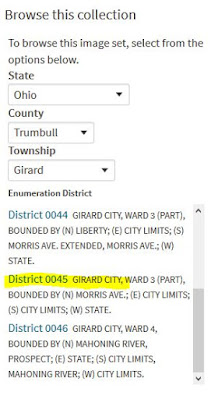Have you ever looked at a document in your family tree, let's say a census sheet, and realized you also need a family that lived on the same block? How do you get back to that census collection online (so you can see the surrounding pages) when all you have is the one document you saved?
You can look at the top of a census sheet and gather enough information to help you get to the general area where you want to look. For example, this 1930 census sheet is from Girard City, Trumbull County, Ohio, enumeration district 78-45, sheet 16B.
| Top of a census sheet |
With those facts I was able to use ancestry.com to easily drill down to the right link, containing 36 images. Because I knew it was sheet 16B, I was able to go right to image 32 and find the exact page I wanted. I can then go page by page to look for a related family that I believe lived nearby.
 |
| Searching for a particular census |
But it isn't always that clean and easy. The top of the census sheet might be hard to read or the information incomplete.
Other documents are harder to rediscover, such as a ship manifest. This is the top of my grandfather's ship manifest from 1920.
| A ship manifest with no ship name |
It tells me that he arrived in New York on 29 November 1920, but what was the name of the ship? I can find a particular ship arriving on a particular day on ancestry.com, but if more than one ship arrived on that day, I may have a lot of images to look at.
To allow myself—and anyone who feels they may have a connection to my tree—to rediscover any of my saved documents, I add enough detail to the image in Family Tree Maker to make that search easy.
For a census sheet I indicate the line numbers to look at, the city, county and state, the enumeration district, sheet number, and image number, which can be a real time-saver.
 |
| Adding enough details to enable anyone to locate the original |
When I decided to add this information, I spent a whole weekend updating every census sheet in my tree. Now I simply add the information the moment I add the new image. It's a practice that will pay off, and absolutely fortifies your family tree.
